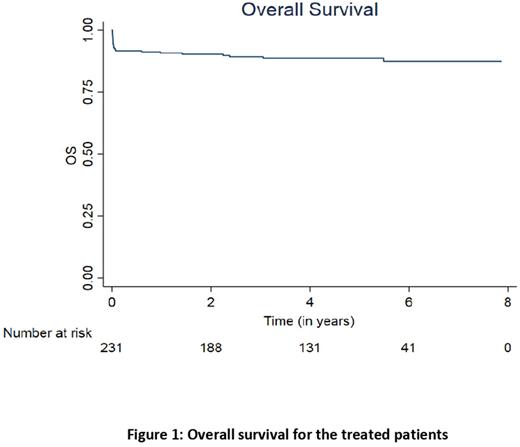Abstract
Treatment outcomes of acute promyelocytic leukemia (APL) show variation between clinical trials and real-world setting largely due to exclusion of patients who present with major bleeding, severe infections and those who die within the first week. Use of differentiation agent-based therapy for low/intermediate risk group (ATRA and ATO) and limiting anthracycline use to high-risk subgroup has reduced the treatment-related mortality beyond first week. However, use of steroids for treatment of differentiation syndrome and chemotherapy can still increase the risk of infections which can compromise the outcomes, particularly in a setting with high incidence of multi-drug resistant organism and invasive fungal infections. There is a need to identify the predictors of this mortality and ways to reduce it to improve the outcomes.
We analyzed the data for patients with newly diagnosed APL from two large tertiary care centers in India, registered between 2013-2018to evaluate the outcomes in all risk groups (as per Sanz score), mortality within first 30-days and prognostic factors. Patients with low/intermediate risk were treated with ATRA and ATO based therapy whereas the high-risk group received chemotherapy in addition to ATRA/ATO. We recorded demographic variables, white blood cell count and platelet count at diagnosis, Sanz score, serum albumin, serum creatinine, treatment administered, achievement of morphological complete remission post induction and complete molecular remission post consolidation, relapse and death. The primary outcome was event-free survival (EFS) which counted lack of complete remission post induction, lack of complete molecular remission post consolidation, relapse and death as event. The secondary outcomes were relapse-free survival (RFS), overall survival (OS) and induction mortality (death within first 30 days) and assessment of impact of baseline disease and host factors on the EFS, RFS, OS and induction mortality.
A total of 238 patients were included in this analysis. The median age was 34 years (range 2-72 years) with male: female ratio of 1.5:1. At presentation the median WBC count was 6790 per cumm (range 300-237,000per cumm) and median platelet counts were 21000 per cumm (3000-266,000 per cumm). As per Sanz score - 12% were low-risk, 48% were intermediate risk and 40% were high-risk. Median fibrinogen levels were 239 (range 36-883). A total of 231 patients received therapy. A total of 204 patients were assessed for response at the end of induction and all but one patient achieved complete response (87.8% as per intention to treat). The rest were not assessable due to death during induction (19) and loss to follow up (15). The induction mortality was 8.2% (infections-6, coagulopathy-9, differentiation syndrome-2 and others-2).170/185(92%) patients achieved post consolidation complete molecular remission. A total of 19 patients relapsed during the follow up (bone marrow-14, CNS alone-2 and combined -3). The median time to relapse was 23.9 months (IQR 13.6-42.9 months).
At a median follow up of 51.2 months,3-year EFS, RFS and OS were 79%,92% and 88%.
There was no statistically significant difference between low, intermediate and high-risk group for any of the survival outcomes. Similarly, age, gender, fibrinogen and albumin at diagnosis did not have any adverse impact. Baseline WBC of >40000/cumm and serum creatinine of >2 mg/dL at diagnosis adversely affected the overall survival with HR of 3.22 (95% CI 1.42-7.29, p-0.005) and 11.9 (95% CI-2.78-50.82)respectively. However, the number of patients with raised creatinine were very small (n=4). These two factors had adverse impact on induction mortality too (WBC>40,000 per cumm - HR -3.32, 95% CI-1.31-8.42, p-0.012 serum creatinine >2 mg/dL- HR 14.69, 95% CI-3.36-64.18, p<0.0001). The survival probabilities at 3, 4 and 5 years using 30-day landmark analysis were 96%, indicating that there are very few deaths after the first 30 days of induction. Fig 1 depicts the overall survival.
This retrospective analysis highlights that ATO+ATRA and minimal anthracycline based therapy has led to similar outcomes in all risk groups and the present need to address induction mortality. High induction mortality in patients with WBC >40,000/cum indicates the potential contribution of infections due to use of steroids to treat differentiation and underlying coagulopathy or a different biology.
Disclosures
Jain:ImmunoAdaptive Therapy Pvt Ltd: Research Funding; Intas Pharmaceuticals Pvt Ltd, Cipla Pharmaceuticals Pvt Ltd: Research Funding; Zydus Lifesciences Ltd: Research Funding; Cipla Pharmaceuticals Pvt Ltd: Research Funding.
Author notes
Asterisk with author names denotes non-ASH members.


This feature is available to Subscribers Only
Sign In or Create an Account Close Modal